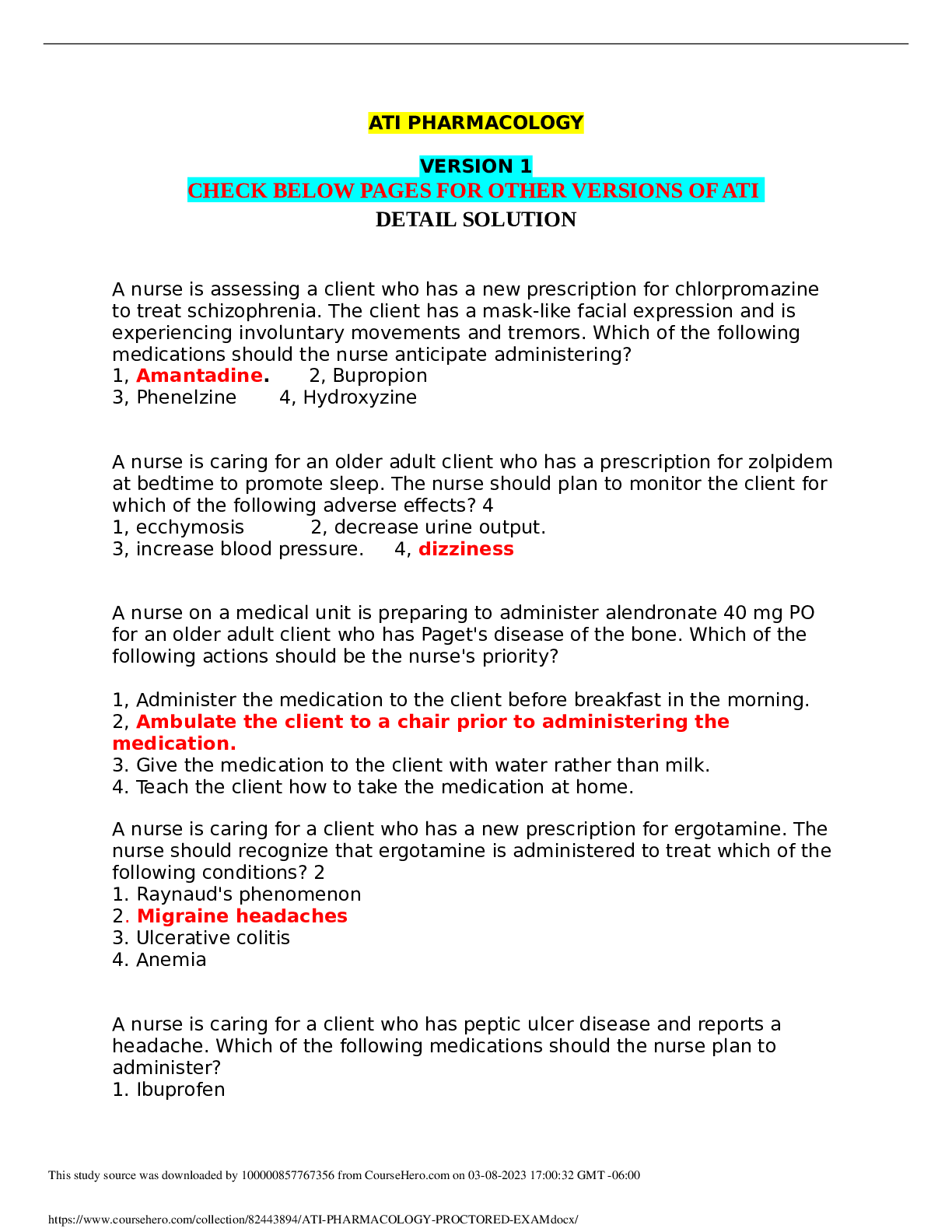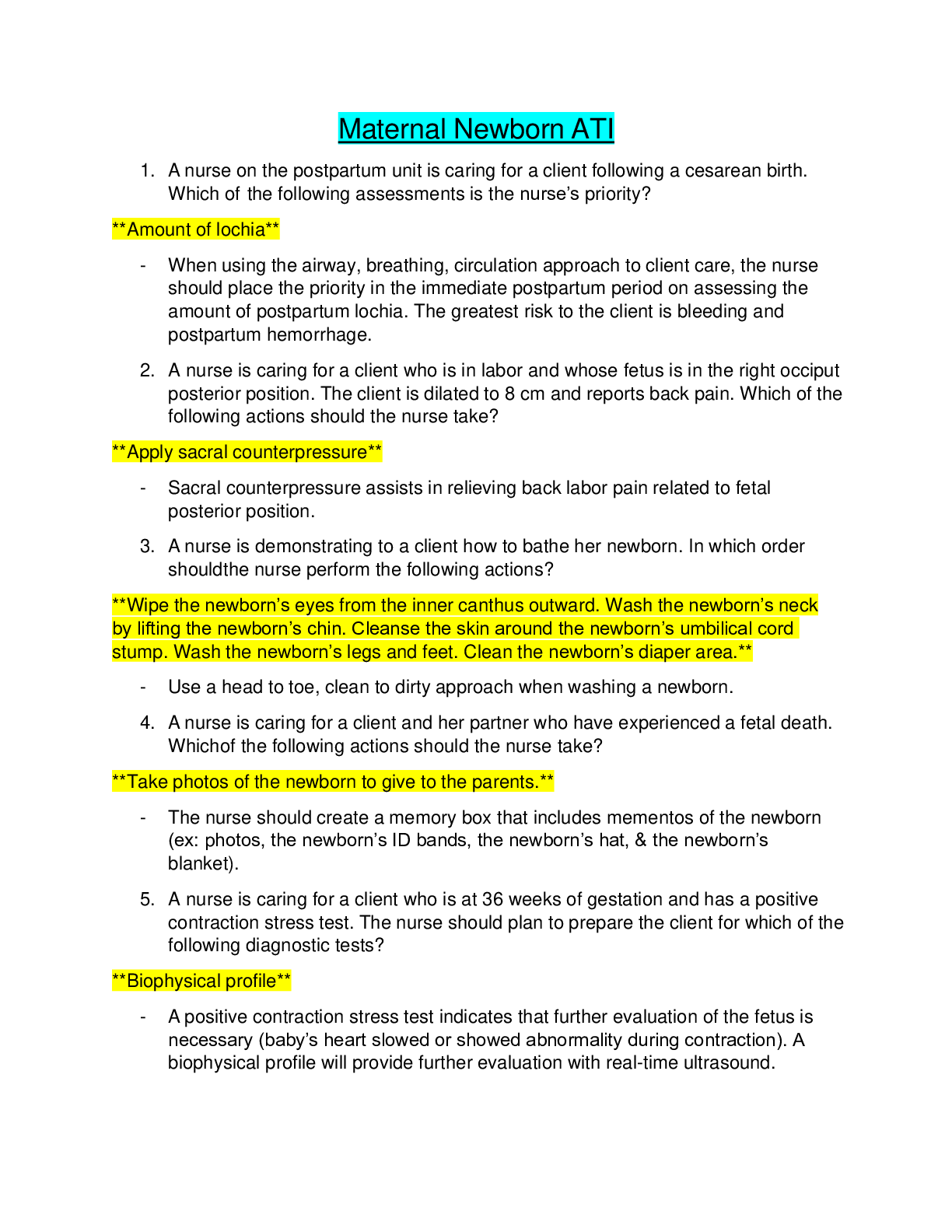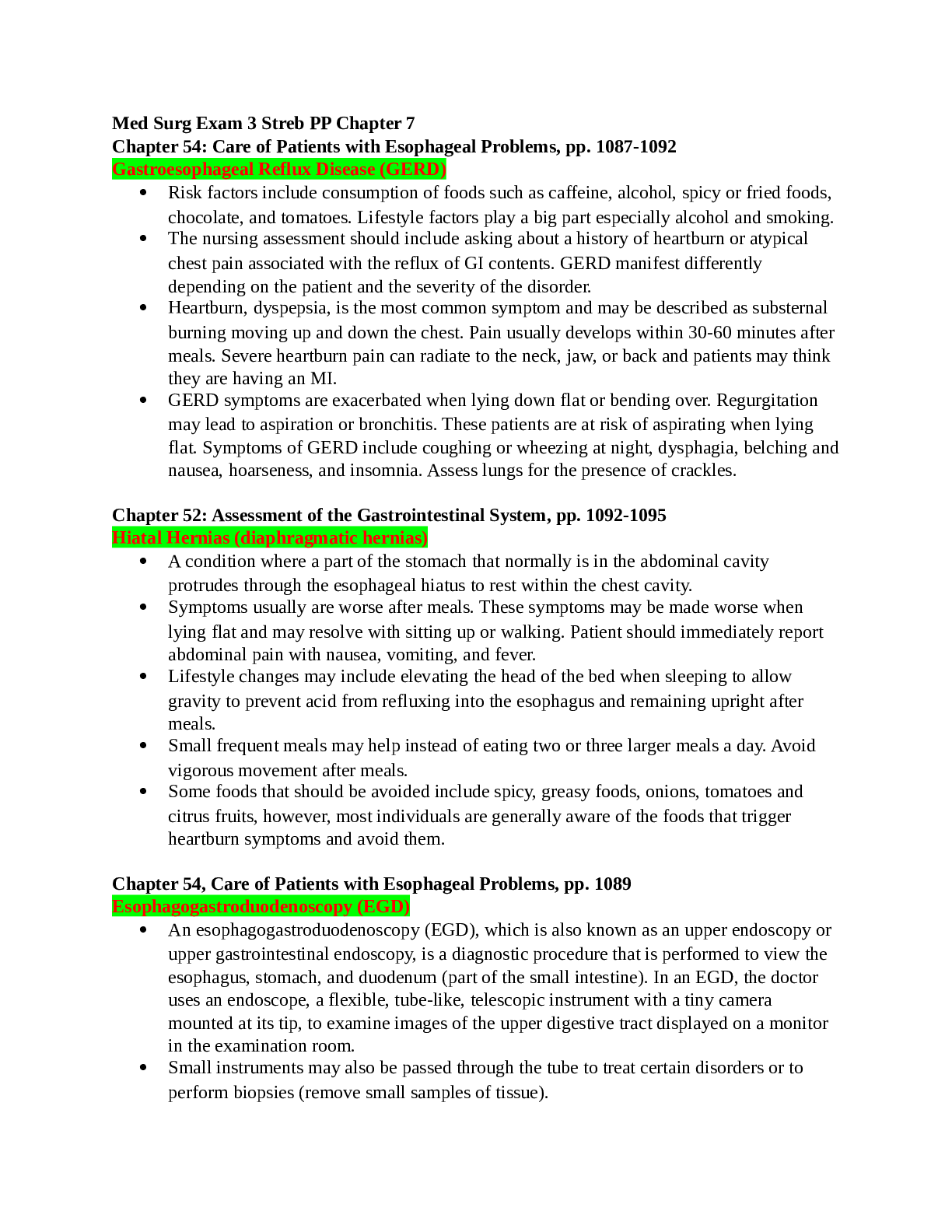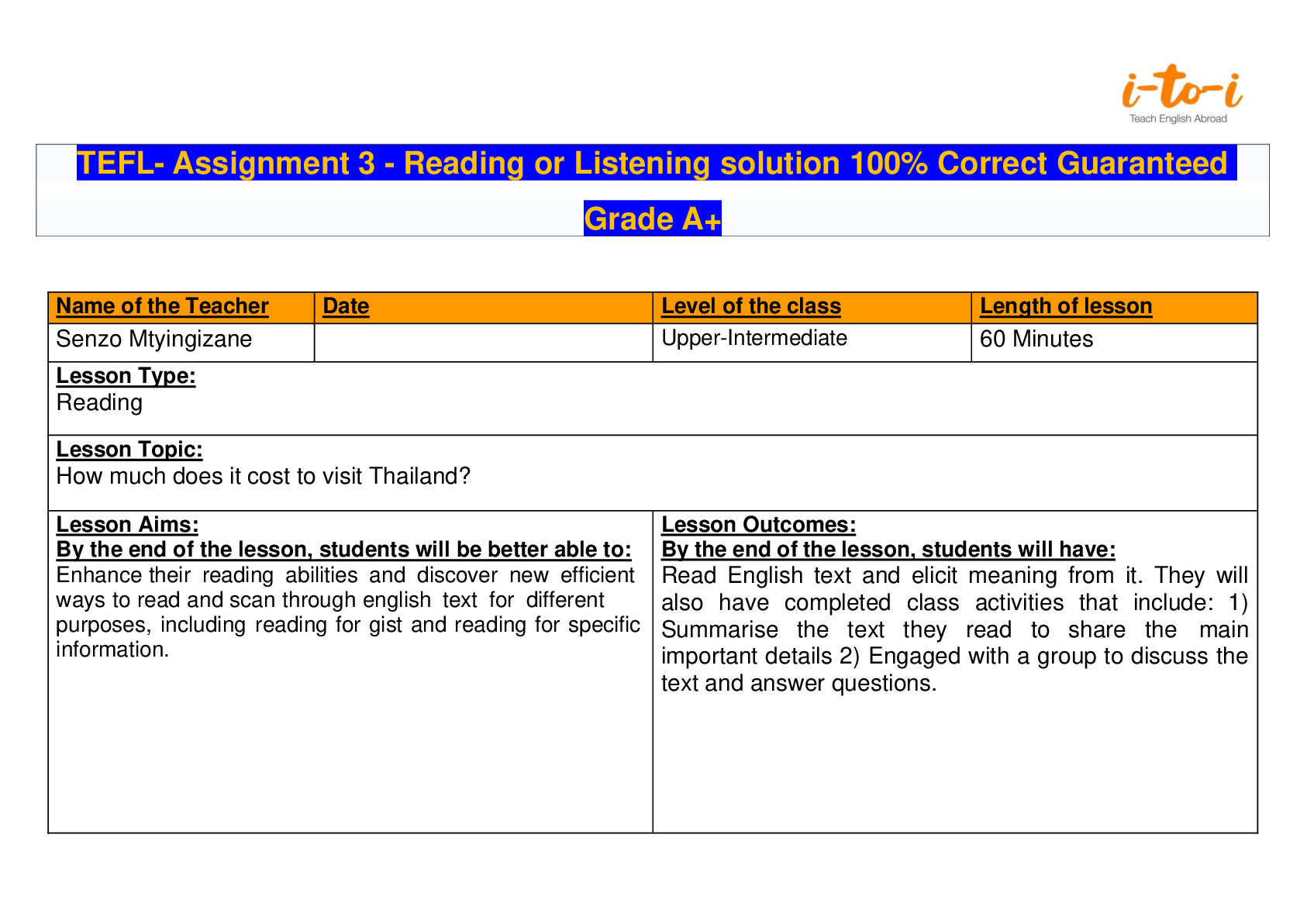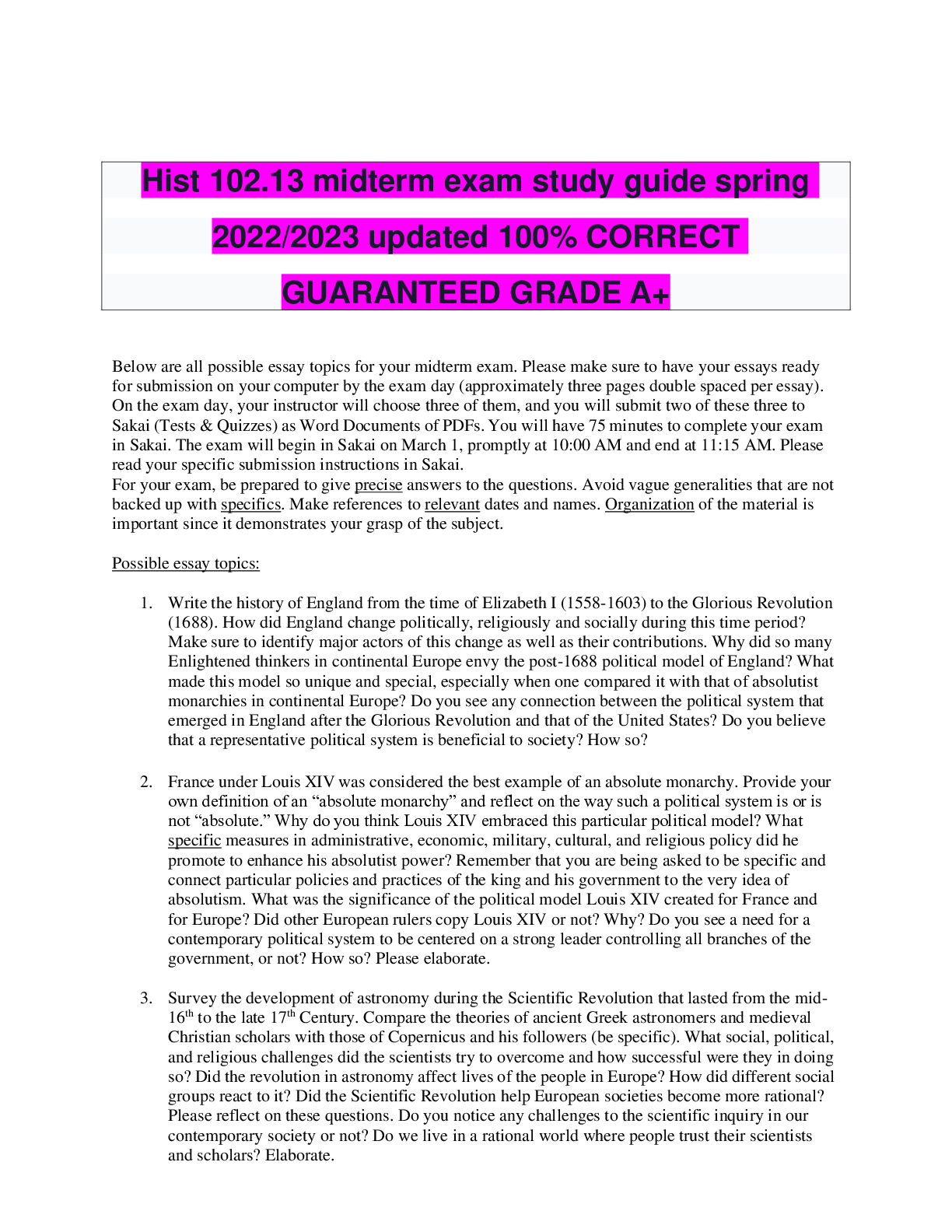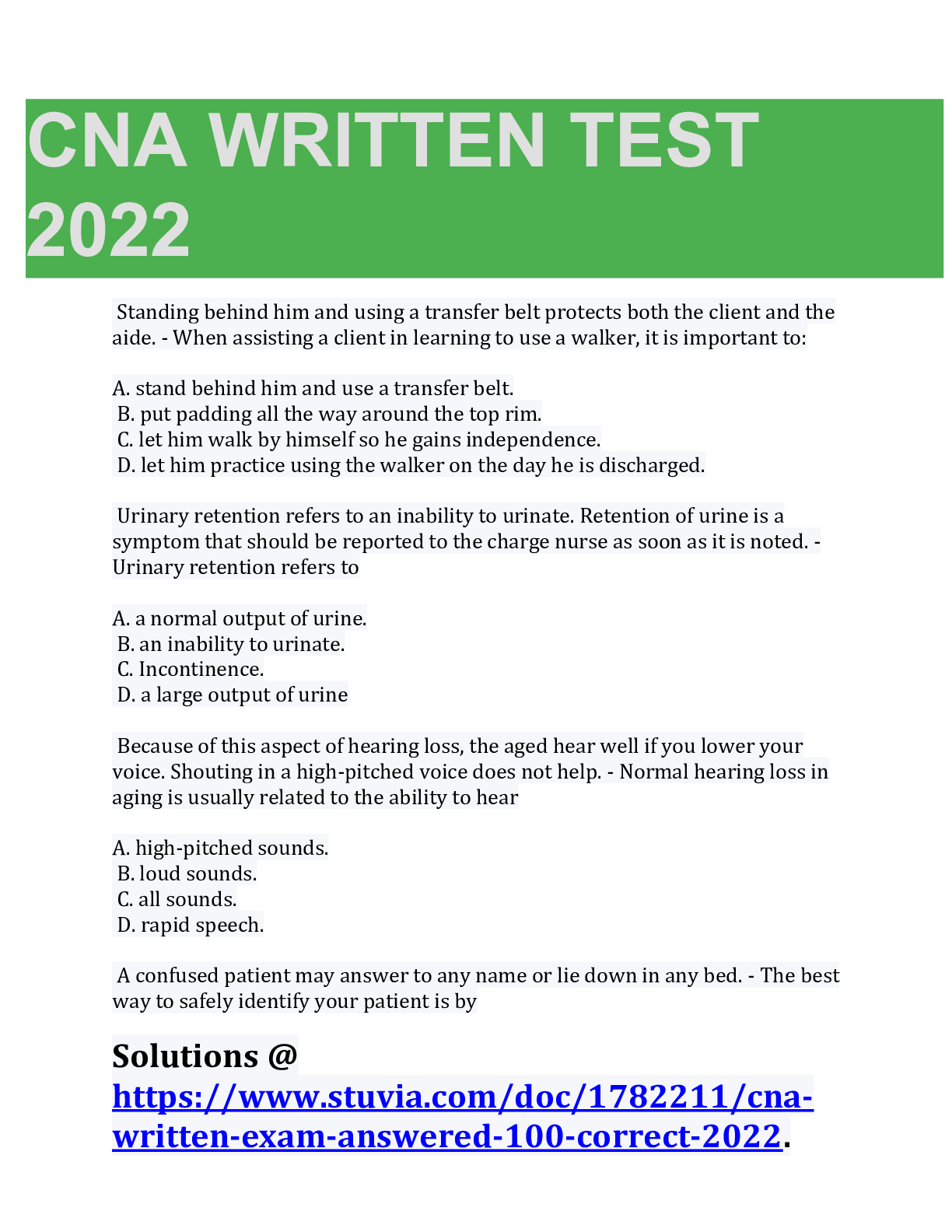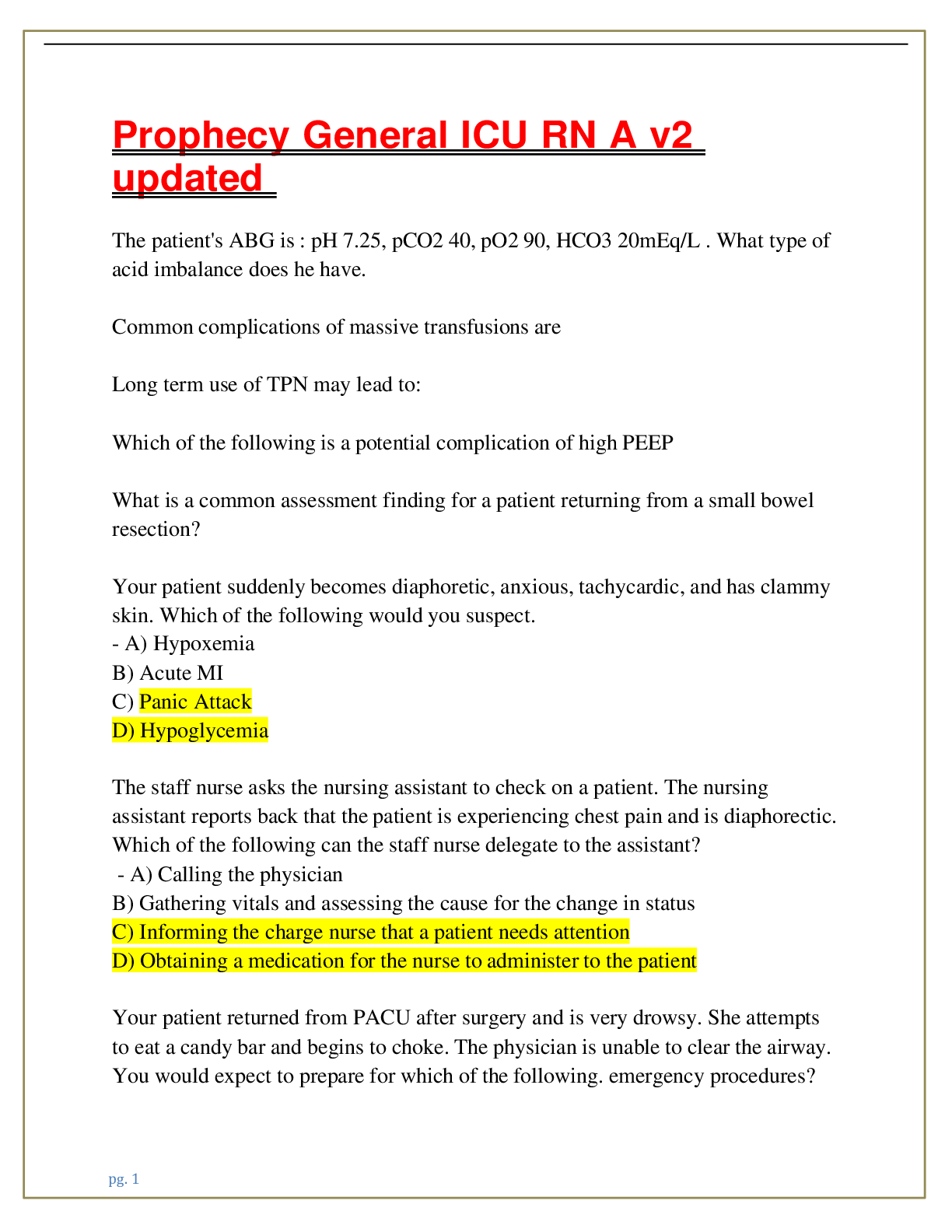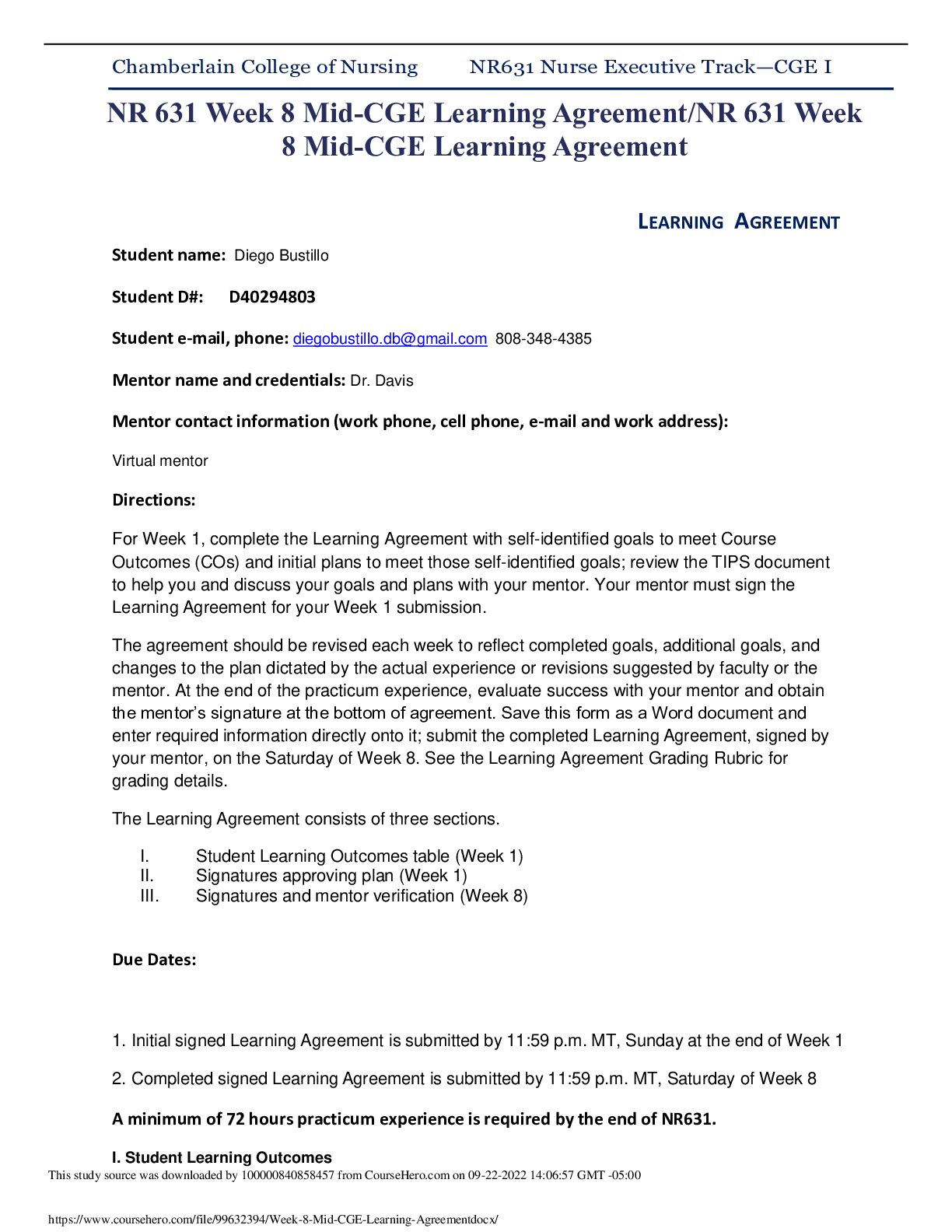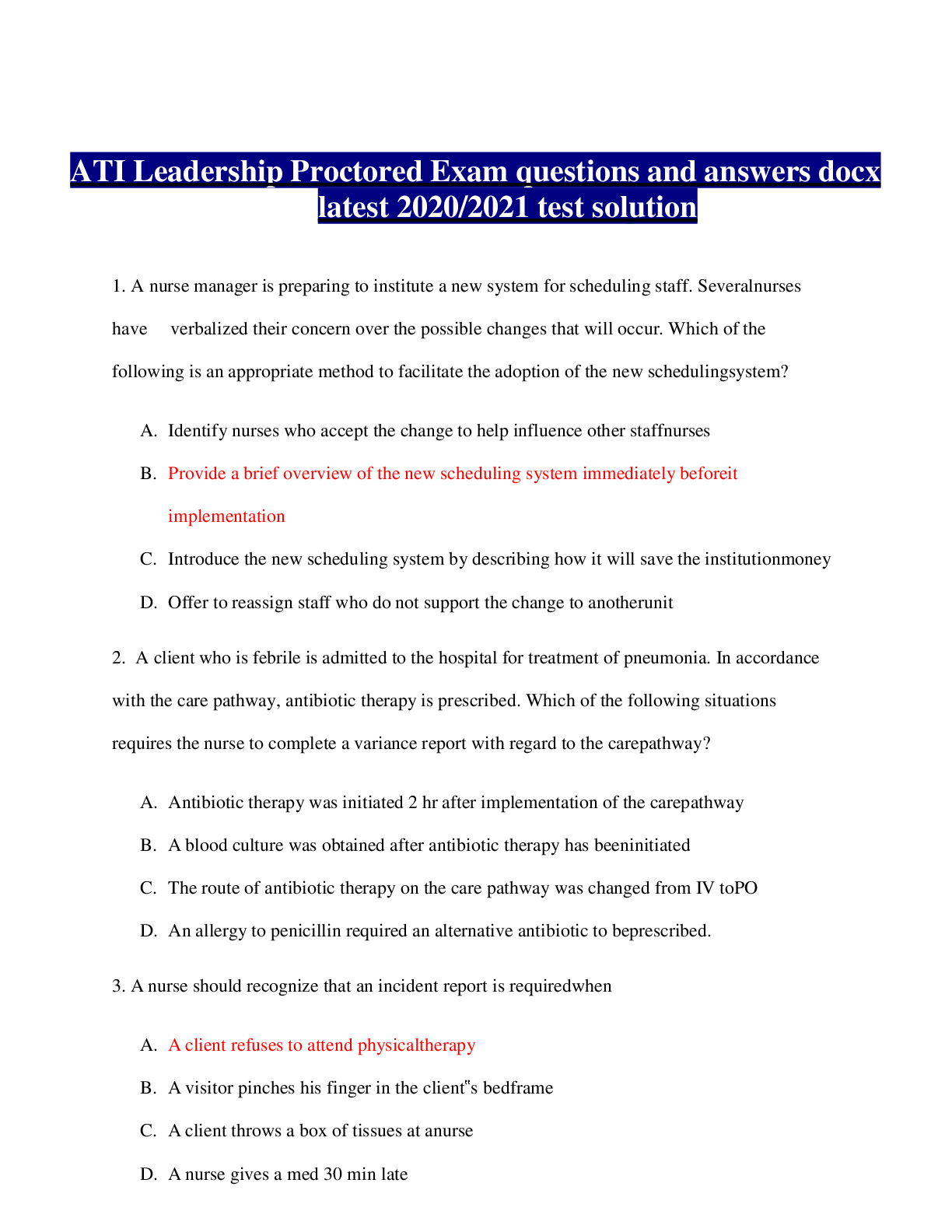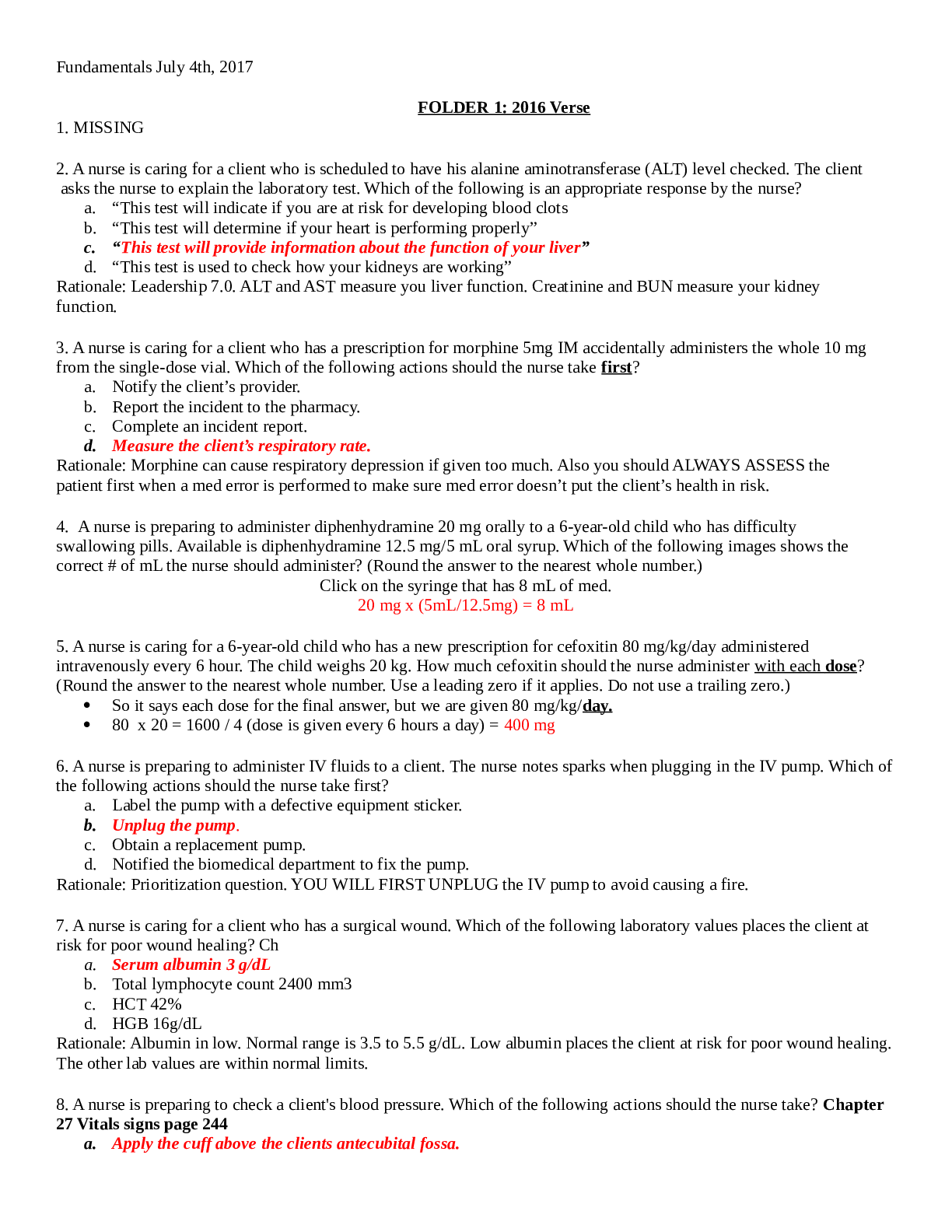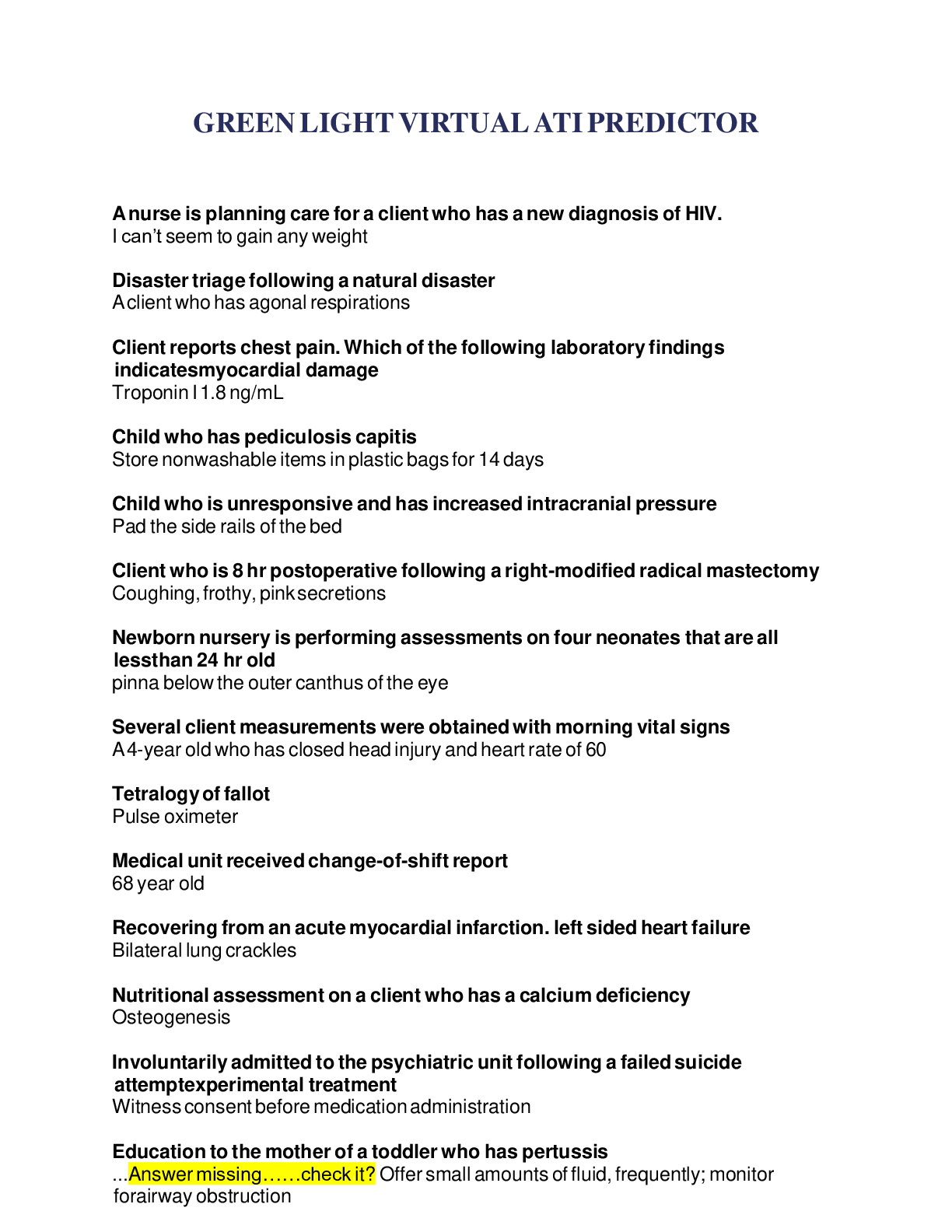*NURSING > QUESTIONS and ANSWERS > NR 505NP CITI TRAINING QUIZ (Consent with Subjects Who Do Not Speak English) | 100% CORRECT GUARANTE (All)
NR 505NP CITI TRAINING QUIZ (Consent with Subjects Who Do Not Speak English) | 100% CORRECT GUARANTEED
Document Content and Description Below
Consent with Subjects Who Do Not Speak English Quiz Results You correctly answered 3 of 5 quiz questions. Question 1 Question A subject who does not speak English in the U.S. may indicate ot... her areas that must be considered and addressed by researchers. Which of the following is most typically an associated concern? Your Answer Cultural differences Result Correct Comment Not speaking English in the U.S. typically indicates cultural differences (such as, deference to authority), which must be considered and addressed. Ignorance, lack of formal education, and incapacity are not directly associated with an inability to speak a second language. Question 2 Question Informed consent can be facilitated in a variety of ways. Which of the below is the best way to enhance the understanding of research? Your Answer Reading the consent form to subjects in their native language. Result Incorrect Correct Answer Asking a staff person who speaks the subject’s language fluently to explain the concepts in the consent form. Comment Asking a staff person who speaks the subject’s language fluently to explain the form is the best option presented above to enhance subject understanding. Reading the consent to a subject, testing, and improving the readability and design of the consent form does not necessarily enhance understanding; a two-way conversation is needed. Question 3 Question When a researcher is conducting an interpreter-mediated consent discussion with subjects, which of the following is an appropriate action for the interpreter? Your Answer The interpreter may explain research-related terms to the subject using culturally relevant examples. Result Correct Comment The interpreter may explain research-related terms to the subject using culturally relevant examples; for example, explaining randomization as the tossing of prayer stones rather than pulling numbers from a hat. An interpreter is not allowed to share his or her opinion with the subject regarding concerns they may have related to the researcher’s study plan according to the National Standards of Practice. The interpreter must remain transparent at all times, only interpreting what has been said by researcher and subject. Question 4 Question In certain circumstances, the federal regulations permit researchers to enroll subjects without a written translation by using a "short form" written consent document, in a language the subject understands. Researchers should know that the use of a short form is conditioned upon: Your Answer IRB approval of a written summary of information to be presented Result Correct Comment 21 CFR 50.27(b)(2) (Protection of Human Subjects 2015) and 45 CFR 46.117(b)(2) (Protection of Human Subjects 2017) state that “the consent form may be…: A short form written consent document stating that the elements of informed consent … have been presented orally to the subject or the subject's legally authorized representative.” When this method is used, there shall be a witness to the oral presentation. In addition, the IRB shall approve a written summary of what is to be said to the subject or the representative. An information sheet may be close to what the regulations require, but there is no requirement for a specific reading level. While a witness is required when using a short form, a LAR is not. There is no requirement for researcher fluency. Question 5 Question Federal regulations (21 CFR 50.20 and 45 CFR 46.116) state that the information given in the consent process must be: Your Answer In a consent form printed in a language readable by the subject Result Incorrect Correct Answer In language understandable to the subject Comment Federal regulations state that information given in the consent process must be in language understandable to the subject. While this generally would be a language the subject speaks, this is not specifically required by the regulations and there is no requirement for fluency. 21 CFR 50.20 and 45 CFR 46.116 address the consent process, not the consent form – the written form might only be a statement that the information has been provided. There is no federal requirement for back-translation, although most IRBs require some type of verification that translations are accurate. Consent with Subjects Who Do Not Speak English Quiz Results You correctly answered 5 of 5 quiz questions. Question 1 Question When a researcher is conducting an interpreter-mediated consent discussion with subjects, which of the following is an appropriate action for the interpreter? Your Answer The interpreter may explain research-related terms to the subject using culturally relevant examples. Result Correct Comment The interpreter may explain research-related terms to the subject using culturally relevant examples; for example, explaining randomization as the tossing of prayer stones rather than pulling numbers from a hat. An interpreter is not allowed to share his or her opinion with the subject regarding concerns they may have related to the researcher’s study plan according to the National Standards of Practice. The interpreter must remain transparent at all times, only interpreting what has been said by researcher and subject. Question 2 Question One way to enhance the understanding of research through the consent process for non-English speakers is to train research assistants to use which of the following when explaining the purpose of the research study and study procedures to potential subjects. Your Answer Teach-back method Result Correct Comment Training research assistants to ensure their understanding of possible language barriers, and explaining the purpose of the research study to potential subjects when obtaining consent as well as the use of teach-back methods are recommended tools to inform about consent and authorization, and to verify comprehension. Question 3 Question Researchers should engage certified interpreters to ensure the subject’s comprehension. Even so, communication and comprehension may be difficult. The best strategy for the researcher is to: Your Answer Meet with the interpreter prior to meeting with the subject to ensure the interpreter understands the terms and concepts. Result Correct Comment It is essential to meet with the interpreter before meeting with the subject to ensure that the interpreter is familiar with the specific terminology related to the research plan as well as any new concepts that may be unfamiliar. Understanding the study in advance helps ensure accurate and complete interpretation. In addition, the interpreter can discuss any cultural concerns that may arise based on the type of study. Surveying family and friends could be intrusive, violate privacy, and undermine the subject’s confidence. To be truly informed, the consent process must be responsive to an individual’s needs. Question 4 Question The consent process must allow subjects to consider whether or not to participate. Which of the following would be the best way to enhance subject understanding for non-English speakers? Your Answer Providing interpreters and time for discussion with advocates during the consent discussion. Result Correct Comment The best option above to enhance subject understanding is providing interpreters and time for discussion with advocates during the consent discussion. Use of family members is problematic and use of professional interpreters is preferable. A multi-step process may be somewhat helpful for language issues, but is more useful to address cultural issues such as deference to authority. Mailing consent forms may not be practical and may introduce other difficulties. While the pause between the two events might give some time, there is no guarantee and the researcher may, in fact, add some element of undue influence. Question 5 Question When developing a research project that will enroll non-English speakers, researchers should: Your Answer Prepare consent documents at an eighth-grade reading level or lower and budget for the cost of translation. Result Correct Comment Challenges of research are magnified when obtaining consent from subjects with low literacy levels and who speak languages other than English. It is best to create consent forms at an eighth grade reading level or lower to ensure readability and comprehension. In addition, translation of documents is a costly endeavor depending on the language and the number of documents or languages required to translate for study purposes. History and Ethics of Human Subjects Research Quiz Results You correctly answered 4 of 5 quiz questions. Question 1 Question Which of the following is included in the Nuremberg Code: Your Answer Voluntary consent Result Correct Comment The Nuremberg Code included the requirement of the voluntary consent of subjects. While all of the choices are valid ethical concerns, none of the other choices were included in the Nuremberg Code. Question 2 Question Which of the following was the result of the Beecher article? Your Answer Realization that ethical abuses are not limited to the Nazi regime Result Correct Comment The primary result of the Beecher article was to expose ethical abuses occurring in research involving human subjects in the US, well after the revelations about research by the Nazi regime. Question 3 Question Which of the following brought increased public attention to the problems with the IRB system? Your Answer Death of Research Subject (Jesse Gelsinger) Result Correct Comment Although all of these are related to the problems with the IRB system, the death of a research subject (Jesse Gelsinger) was what received public attention. Question 4 Question Issued in 1974, 45 CFR 46 raised to regulatory status: Your Answer US Public Health Service Policy Result Correct Comment 45 CFR 46 raised to regulatory status the US Public Health Service policy of 1966 "Clinical research and investigation involving human beings”. Question 5 Question The use of prisoners in research is a concern under the Belmont principle of Justice because: Your Answer Prisoners are not free to say no Result Incorrect Correct Answer Prisoners may not be used to conduct research that only benefits the larger society Comment The Belmont Principle of Justice requires the equitable distribution of both the benefits and burdens of research. Prisoners should not bear the burden of participating in research that only benefits the larger society. Basic Institutional Review Board (IRB) Regulations and Review Process Quiz Results You correctly answered 5 of 5 quiz questions. Question 1 Question A subject in a clinical research trial experiences a serious, unanticipated adverse drug experience. How should the investigator proceed, with respect to the IRB, after the discovery of the adverse event occurrence? Your Answer Report the adverse drug experience in a timely manner, in keeping with the IRB's policies and procedures, using the forms or the mechanism provided by the IRB. Result Correct Comment The most appropriate action for the investigator to take is to report the adverse drug experience in a timely manner using the forms provided by the institution. Question 2 Question How long is an investigator required to keep consent documents, IRB correspondence, and research records? Your Answer For a minimum of three years after completion of the study Result Correct Comment Research investigators are responsible for retaining signed consent documents, IRB correspondence, and research records for at least three years after completion of the research. Because research records are the property of the institution, local institutional policy or sponsoring agency requirements may dictate these records are kept longer. The sponsor and the IRB office should be contacted to make sure that the minimum of three years meets their requirements. Question 3 Question According to federal regulations, which of the following best describes when expedited review of a new, proposed study may be used by the IRB? Your Answer The study involves no more than minimal risk and meets one of the allowable categories of expedited review specified in federal regulations Result Correct Comment The study involves no more than minimal risk and meets one of the allowable categories of expedited review specified in federal regulations. Expedited review procedures are appropriate only for protocols that present no greater than "minimal risk" to subjects and involve only procedures included in federally specified categories. Population considerations, such as healthy volunteers, are only relevant insofar as they affect the assessment of risk. The IRB may not conduct an expedited review for the convenience of either the IRB or a student researcher, if the protocol is otherwise not eligible. Question 4 Question Amendments involving changes to IRB-approved protocols do NOT need prior IRB approval if: Your Answer The changes must be immediately implemented for the health and well- being of the subject. Result Correct Comment All amendments involving changes to IRB-approved protocols must be reviewed and approved in advance of implementation, unless changes must be put in place immediately to respond to an unexpected risk or problem arising during the course of a study. Question 5 Question IRB continuing review of a greater than minimal risk approved protocol that is currently enrolling subjects must: Your Answer Occur at least annually. Result Correct Comment Approved greater than minimal risk protocols must be reviewed at least annually, although IRBs may specify a shorter review period. It is the responsibility of the principal investigator to hold signed consent forms in confidentiality. Copies of these forms are not required by federal regulation to be reviewed by the IRB. Please note, however, that an institution's local policy may require copies of signed consent forms as part of the IRB continuing review process. Informed Consent Quiz Results You correctly answered 4 of 5 quiz questions. Question 1 Question The purpose of informed consent is: Your Answer To provide a potential subject with appropriate information in an appropriate manner and allow that person to make an informed decision about participation in research. Result Correct Comment The purpose of the Informed Consent process is to ensure human research subjects are provided all of the information necessary to make informed choices about participating in research. Question 2 Question A general requirement for the informed consent form is that it may not include any exculpatory language. Exculpatory language is that which waives or appears to waive any of the subject's legal rights or releases or appears to release those conducting the research from liability for negligence. Which of the following statements in a consent form is an example of exculpatory language? Your Answer Your participation in this research is voluntary. If you choose not to participate, or change your mind later, your decision will not affect your relationship with your doctor or your right to health care or other services that you may be eligible for. Result Incorrect Correct Answer I waive any possibility of compensation for injuries that I may receive as a result of participation in this research. Comment Exculpatory language is written content in the consent document through which the subject is made to waive or appear to waive any of the subject's legal rights, or releases or appears to release the investigator, the sponsor, the institution, or its agents from liability for negligence. Such language is specifically prohibited. Question 3 Question An investigator is confronted with a life-threatening situation that necessitates using a test article in a human subject who is unable to provide informed consent and there is no time to obtain consent from the individual’s LAR and no alternative method or recognized therapy is available. Under the FDA regulations for using test articles, which of the following describes the best course of action for the investigator: Your Answer The investigator and an independent physician agree that the situation necessitates the use of the test article. An exception or waiver for informed consent can be made under these circumstances. The IRB will be notified later. Result Correct Comment The life- threatening situation requires a timely decision so that the test article can be ethically used. It would be unethical to withhold emergency treatment until a research protocol is submitted and approved by the IRB. Not using the test article in a situation where it might save a life is also unethical. The Federal regulations (21 CFR 50.24) provide the option of using the test article in a life-threatening condition involving an individual subject where the following requirements for an exception from informed consent are met. 1. The investigator, with the concurrence of another physician, believes the situation necessitates the use of a test article (i.e., an investigational drug, device, or biologic). 2. The subject and/or legally authorized representative is unable to communicate consent 3. There is insufficient time to obtain consent. And 4. No alternative exists that will provide an equal or better chance of saving the subject's life. Question 4 Question A 46-year-old man is currently enrolled in a Phase 2 study of a drug for severe diabetic neuropathy. While the study is on-going, a new drug becomes commercially available that may have equal or greater benefit to the subject. The investigator should do which of the following? Your Answer Give the subject comprehensive information about the new drug, including its side effects. Discuss the pros and cons of both the investigational drug and the commercially available drug and then allow the subject to decide whether to withdraw from the research to take the new drug. Result Correct Comment Phase 2 clinical trials involve volunteers who have the disease or condition to be treated. These trials help physicians and researchers begin to learn more about the safety of the new drug treatment and how well the drug treats the targeted disease or condition. Several different doses of the drug may be tested to see which dose has the desired effects. Subjects are monitored for side effects and for any improvement in their illness, symptoms, or both. Informed consent is not a one-time procedure but a continuing and ongoing process. 45 CFR 116(b) and 21 CFR 50.25(b) require that the Informed Consent document include a statement indicating that if significant new findings are developed during research which may relate to the subject's willingness to continue, they will be explained to the subject. The Informed Consent document must also describe the process whereby subjects will be notified of significant new findings. Question 5 Question An elderly gentleman, whose wife is his legally authorized representative (LAR) since his strokes several years ago, was recently diagnosed with lung cancer. He is eligible for a clinical trial using a new investigational drug that aims to treat lung cancer. He is able to express interest, shows a basic understanding of the nature of the trial, and gives his assent to participation. The subject's wife is out of town on a business trip. Which of the following is the most appropriate action to take for the investigator? Your Answer Send a copy of the informed consent via facsimile to the subject's wife. After she has had the opportunity to speak to the investigator, she can sign the informed consent and fax it back. Result Correct Comment The IRB will not provide a waiver of consent under these circumstances and the man should not be excluded from the study simply because his legally authorized representative is temporarily unavailable to sign in person. Verbal approval does not satisfy the FDA requirement at 21 CFR 56.109(c) of signed informed consent document. When obtaining consent from a legally authorized representative (LAR) who is not able to provide signed consent in person, it is acceptable to send the informed consent document to the LAR by facsimile and conduct the consent interview by telephone when the LAR can read the consent as it is discussed as noted in the FDA's FAQs. If the LAR agrees, he/she can sign the consent and return the signed document to the clinical investigator by facsimile. SOCial and Behavioral Research (SBR) for Biomedical Researchers Quiz Results You correctly answered 4 of 4 quiz questions. Question 1 Question A researcher is conducting a written survey about people's attitudes toward walking as an exercise option at the local shopping mall that supports a walking program. The survey is anonymous (without codes, names, or other information) and subjects may complete the survey and place it in a box at the shopping mall exits. Which of the following is the most important issue that the researcher addressed in planning the research? Your Answer Confidentiality of the individual subject's responses Result Correct Comment The most important issue that the researcher addressed in planning the research is the confidentiality of the individual subject's responses. By making the survey anonymous, no one, even the researcher, has knowledge of the individual's identity. While recruitment strategies, minimizing emotional distress, and having a large sample size are important issues to address, the confidentiality of the individual subject responses is the most important in this example. Question 2 Question A researcher wants to invite therapists to participate in small focus groups to discuss their perceptions regarding "troubled" adolescent girls and the relationships they have with their parents. Specific clients of the therapists will not be discussed. Which of the following will be the most important issue for the researcher to consider when planning the research? Your Answer Breach of confidentiality from the focus group subjects (therapists) Result Correct Comment Most risks of harm from SBR research results from invasion of privacy and breaches of confidentiality. Researchers should design strategies to minimize the possibility of breaches of confidentiality and inform all subjects about the potential for these breaches especially in a focus group situation. While emotional distress, compensation and recruiting strategies are all important issues for the researcher to consider in this situation, the potential for breach of confidentiality is the most important. Question 3 Question Which of the following most accurately describes the risks associated with SBR? Your Answer Less predictable, more variable, and less treatable than physical harms Result Correct Comment It is more difficult to predict how individuals will react to questions and situations in which their behavior is observed or manipulated than to physical data collection methods such as blood draws. The reactions may be of considerable duration. Once those reactions happen, they may be difficult to assess, serious enough to require treatment and may even be untreatable compared to treating physical harms. Question 4 Question Which of the following is considered a SBR data collection method? Your Answer Interviews Result Correct Comment Hearing screenings, blood draws, and other physical exams are usually designed to collect physiological data, not information about attitudes and beliefs. Interviews are designed to collect information about attitudes, beliefs, and behavior and are data collection methods typically used by SBR researchers. Genetic Research in Human Populations Quiz Results You correctly answered 4 of 5 quiz questions. Question 1 Question Which of the following statements is accurate in determining subject risk involved in a genetic study: Your Answer Understanding the purpose and context of a specific study is critical in determining the risk involved Result Correct Comment Genetic research covers a broad spectrum of research from surveys and chart reviews to gene transfer studies. Therefore no assumptions should be made about risk in genetic research – each study must be evaluated on its own merits. Question 2 Question Investigator A conducts research on emphysema using biospecimens from human subjects. The consent form indicates that the research will focus exclusively on emphysema. Investigator B wishes to use the biospecimens for research on lung cancer. Can Investigator B use the specimens for cancer research without re-consent if the specimens are de-identified? Your Answer Yes, if the biospecimens are de-identified then the research is no longer considered human subjects research. Result Correct Comment Under the regulations, research with de-identified specimens is not considered human subjects research. However, many commentators consider it ethically problematic to use specimens in a manner that is not consistent with the language in the informed consent document. Question 3 Question Identify which types of discrimination the Genetic Information Non- Discrimination Act (GINA) protects individuals from: Your Answer Health insurance and employment discrimination Result Correct Comment GINA protects individuals against discrimination in health insurance and employment. Other forms of discrimination are not addressed by GINA. Question 4 Question Which choice best describes the purpose of most pharmacogenomic research? Your Answer To evaluate the association between individual genotypes and the safety and efficacy of a particular drug or class of drugs Result Correct Comment Pharmacogenomics has broad goals to understand the relationship between individual genotypes and individual response to drugs in terms of safety and efficacy. This knowledge may reduce cost but that is not the primary purpose of this research. Question 5 Question As of January 2015, the NIH expects investigators to obtain the informed (valid) consent of research participants in NIH -funded genetic research for broad research use of data and data sharing, even if the cell lines or specimens are: Your Answer From subjects over 18 years of age Result Incorrect Correct Answer De-Identified Comment The new NIH policy expects informed (valid) consent even when the source individuals for genetic data are not identifiable (de-identified) to investigators accessing and using the data. Populations in Research Requiring Additional Considerations and/or Protections Quiz Results You correctly answered 5 of 5 quiz questions. Question 1 Question The NBAC looks at characteristics individuals might have that would prevent them from being able to provide voluntary informed consent. The traits may be thought of as falling into six broad areas: cognitive or communicative, institutional, deferential, medical, economic, and social. Prospective research subjects who are not able to comprehend information, deliberate, and make decisions about participation in a proposed research study have a: Your Answer Cognitive or communicative vulnerability Result Correct Comment Prospective research subjects who are not able to comprehend information, deliberate, and make decisions about participation in a proposed research study have a cognitive or communicative vulnerability. Question 2 Question Which is true of inducements in research? Your Answer Inducements constitute an “undue influence” if they alter a potential subject’s decision-making processes, such that they do not appropriately weigh the risk-benefit relationship of the research. Result Correct Comment Inducements are offers that influence people to make decisions, or do things they would not otherwise do. Inducements and the influence they cause may be acceptable, or they may be “undue,” and the distinction is not always clear or universally agreed upon. Offering $10 may be acceptable for an hour-long research study; offering $1000, or a better grade in a class, is probably not appropriate. In general, inducements constitute an “undue influence” if they alter a potential subjects decision-making processes such that they do not appropriately consider the risk-benefit relationship of the research. Question 3 Question Subjects with a serious illness may be at risk for exploitation because they may be desperate for a possible cure. This is an example of: Your Answer Medical vulnerability Result Correct Comment Medical vulnerability arises when prospective subjects have serious health conditions for which there are no satisfactory standard treatments. Subjects with serious health problems may not be able to adequately weigh the risks and potential benefits of the research. Subjects are at risk of exploitation because they may overestimate potential benefit. Deferential vulnerability is similar to institutional vulnerability, but the authority over the prospective subject is due to informal power relationships rather than formal hierarchies. Economic vulnerability arises when prospective subjects are disadvantaged in the distribution of social goods and services (income, housing, or healthcare). Therapeutic misconception occurs when subjects blur the roles played by physician-researchers and fail to appreciate the difference between research and treatment. Question 4 Question A subject participates in a drug study because treatment is available at no or reduced cost, and he could not otherwise afford it. This is an example of: Your Answer Economic vulnerability Result Correct Comment Economic vulnerability arises when prospective subjects are disadvantaged in the distribution of social goods and services (income, housing, or healthcare). Participation in research offers the possibility of payment or attainment of healthcare or other services that are otherwise not available, and induce persons to enroll in a research study when it might be against their better judgment and when otherwise they would not do so. These inducements to enroll threaten the voluntary nature of consent and raise the danger of exploitation. Prospective subjects who belong to undervalued social groups may be subject to social vulnerability. The perception of these groups as less valuable to society could lead to reduced concern (by researchers) for risks of harm and burdens on those groups, and increase the risk of exploitation. Prospective subjects in research who are subject to the formal authority of others may have an institutional vulnerability. These individuals have the cognitive capacity to consent but may not be able to make a truly voluntary choice, and may be unduly influenced (or coerced) to participate when they otherwise might not have done so. Prospective research subjects who are not able to comprehend information, deliberate, and make decisions about participation in a proposed research study have a cognitive or communicative vulnerability. Question 5 Question In considering NBAC’s analytic approach, an otherwise competent person who is acutely ill might be considered at especially high risk of harm for: Your Answer Situational cognitive vulnerability Result Correct Comment Subjects who do not lack capacity, but are in situations that do not allow them to exercise their capacities effectively, may suffer situational cognitive vulnerability. This might occur when a subject is distracted or during an emergency situation, such as an acute illness or injury. Capacity-related cognitive vulnerability can occur when subjects to some extent lack capacity to make informed choices. Communicative vulnerability can occur when subjects do not lack capacity, but due to limited ability to communicate with the researchers are not able to exercise their capacities effectively. Economic vulnerability arises when prospective subjects are disadvantaged in the distribution of social goods and services (income, housing, or healthcare). Research Involving Children Quiz Results You correctly answered 3 of 3 quiz questions. Question 1 Question A federally funded research study involving children 8 to 12 years old involves collecting a single voided urine sample to assess the frequency of asymptomatic proteinuria (higher amounts of protein in the urine without any signs or symptoms of illness or infection). Your IRB has determined that assent of children age 8 and older is required for the study. A 10-year-old firmly declined to participate in the study described above. Which of the following procedures best describes the action to be taken by the investigator? Your Answer Honor the child's decision. Result Correct Comment The assent of minors to participate in research is required, unless the "capability of some or all of the children is so limited that they cannot reasonably be consulted or that the intervention or procedure involved in the research holds out a prospect of direct benefit that is important to the health or well being of the children and is available only in the context of the research" (45 CFR 46.408). The IRB determined that an 8-year-old was capable of providing assent for participation in this study, and in this situation, the child's decision cannot be overruled by the permission from one or both parents. Question 2 Question A federally funded research study involving children 8 to 12 years old involves collecting a single voided urine sample to assess the frequency of asymptomatic proteinuria (higher amounts of protein in the urine without any signs or symptoms of illness or infection). According to 45 CFR 46, an IRB's risk assessment would likely conclude that this study involves: Your Answer No more than minimal risk to the child. Result Correct Comment 45 CFR 46.102(i) defines minimal risk as the "probability and magnitude of harm or discomfort anticipated in the research are not greater in and of themselves than those ordinarily encountered in daily life or during the performance of routine physical or psychological examinations or tests." Because the risk associated with collection of a single voided urine specimen is not greater than risks encountered in the course of a routine physical examination, this research constitutes "minimal risk." Question 3 Question An investigator proposes a study to determine the clinical relevance of a new assay technique to measure minimal residual disease (MRD) in adolescent (age 14-16) cancer patients undergoing chemotherapy. The study requires that two additional bone marrow aspirates be performed during the course of chemotherapy. The subject's chemotherapy will not be altered based on the results of the assay technique measures. However, future patients with cancer would benefit from improved interventions based on study findings. The IRB determined that the activity was a minor increase over minimal risk. Which of the following statements best describes the IRB approval requirements for involving adolescent cancer patients in the research study? Your Answer Assent of the child and permission of both parents are required. Result Correct Comment The research, as described presents greater than minimal risk and no prospect of direct benefit to individual subjects, but is likely to yield generalizable knowledge about the subject's disorder or condition. It is therefore potentially approvable under 45.406, provided: (1) the risk represents a minor increase over minimal risk; (2) the intervention or procedure presents experiences to subjects that are reasonably commensurate with those inherent in their actual or expected medical, dental, psychological, social, or educational situations; (3) the intervention or procedure is likely to yield generalizable knowledge about the subjects' disorder or condition which is of vital importance for the understanding or amelioration of the subjects' disorder or condition; and (4) adequate provisions are made for soliciting assent of the children and permission of their parents or guardians. FDA-Regulated Research Quiz Results You correctly answered 5 of 5 quiz questions. Question 1 Question A sponsor proposes research to evaluate reengineering a commercially available pacemaker. It is hoped that the new pacemaker will pose fewer risks to individuals when compared to the current commercially available product. How should this device be classified? Your Answer Significant risk device Result Correct Comment A significant risk device presents a potential for serious risk to the health, safety, or welfare of the subject and it: (1) Is intended to be implanted into a human; (2) Is used in supporting or sustaining human life; (3) Is of substantial importance in diagnosing, curing, mitigating, or treating disease, or otherwise prevents impairment of human health; or (4) Otherwise presents serious risk to health, safety, and welfare of a subject. Question 2 Question An adult with attention deficit hyperactivity disorder (ADHD) presents to a physician. To date, no behavioral or drug interventions have proven useful. The physician has just read several reports about a drug that is approved and marketed for another indication, but has shown some benefit for ADHD. The physician wants to prescribe this drug, in the labeled marketed dose, for the individual patient. Which of the following would be the most appropriate course of action? Your Answer Treat the patient with the drug based on physician's best medical judgment Result Correct Comment Based on physician's best medical judgment the patient may be treated with the drug since it is a marketed drug with an approved labeled dosage. An IND is not required. There is no research being conducted for the purpose of changing the labeling of the drug or marketing a new indication. Question 3 Question An investigator proposes to study a marketed product sold to treat high blood pressure in individuals over age 12 using a liquid formulation for children under age 12. The drug sponsor hopes that the information from the research can be used to change the labeling for use of the drug in younger children. Which of the following is the investigator's most appropriate course of action? Your Answer Submit the research protocol to the IRB for review and submit an IND application to the FDA before conducting the research Result Correct Comment An IND is required. The investigator and the sponsor are proposing research that may change the formulation of the drug, the dosage, and the population (children) from the currently approved labeling for this drug. An IDE is not required as there is no device involved. Because this research is on drugs, it is under the primary purview of, and regulated by, the FDA, not OHRP. Question 4 Question The FDA's regulations related to electronic records and electronic signatures (21 CFR Part 11) are intended to: Your Answer Allow the use of electronic documents and signatures in the regulatory process for drugs and devices. Result Correct Comment 21 CFR Part 11 Electronic Records; Electronic Signatures; Final Rule, often referred to as Part 11, was published May 20, 1997 and was intended to enable, but not require, the use of electronic documents in the regulatory process for drugs and devices. Part 11 specifies processes that must be in place assuring that electronic documents and signatures are equivalent to paper documents and handwritten signatures. Question 5 Question An academic medical center is selecting a new database system for clinical research. The system needs to be "Part 11 compliant" in order to allow: Your Answer The medical center to replace the use of paper records with electronic records for its research. Result Correct Comment Part 11 specifies processes that must be in place assuring that electronic documents and signatures are equivalent to paper documents and handwritten signature. Therefore, if an institution wants to eliminate all paper records for research, the electronic system must be "Part 11 compliant." Recognizing and Reporting Unanticipated Problems Involving Risks to Subjects or Others in Biomedical Research Quiz Results You correctly answered 5 of 5 quiz questions. Question 1 Question An investigational biologic administered to the first two subjects in a Phase II clinical trial was not appropriately screened for two viral contaminants, HIV and Hepatitis B, due to human error in the screening process. Follow- up testing indicated that the subjects and their partners were not infected. The subjects and others were notified of the increased risk. Your Answer This is an unanticipated problem requiring notification to the IRB and FDA. Result Correct Comment This is an unanticipated problem because the screening procedure problem was not anticipated; both the subject and others were exposed to risk and could have been infected with Hepatitis B or HIV. A Phase II clinical trial involving a biologic falls under the jurisdiction of the FDA. Question 2 Question Housekeeping employees of the medical center were recruited for a federally funded study of blood pressure, blood count levels, infectious disease history, and job stress. The interviews and blood tests were conducted in a private location not affiliated with the study center. Follow- up interviews were conducted in the same location. The study coordinator stopped at the cafeteria on her way back to the study office after the second study visit for the last three study subjects and lost the three file folders. Records of one subject indicated he had a history of a sexually transmitted disease and another had recently been treated for tuberculosis. The subjects were notified of the loss. Following this event, the IRB approved a protocol change requiring that all records be transmitted electronically to the study office using the medical center’s secure network. Your Answer This is an unanticipated problem and not an adverse event. Result Correct Comment Regardless of the type of study, when subjects’ research records containing protected health information (PHI) are lost, the event is considered an unanticipated problem. This event required the subjects be notified of the increased risk, and required a change in the way data were stored and protected. This is not an adverse event because there was no medical occurrence involved. OHRP should be notified. Question 3 Question A subject received the wrong study drug resulting in severe nausea and vomiting, and a visit to the emergency room for treatment. The subject notified the study coordinator the day after the emergency room visit. The study coordinator reviewed the subject’s study records and discovered the error. The coordinator notified the subject of the study drug error, which caused the nausea and vomiting. The investigator notified the IRB and the IRB approved a revision of the standard pharmacy procedure for administering investigational drugs. Your Answer This is an unanticipated problem, which resulted in an adverse event. Result Correct Comment Receiving the wrong study drug is an unanticipated problem because all the criteria for an unanticipated problem are met. This subject required medical treatment suggesting the increased risk was serious. This event is also an adverse event because the subject required medical treatment. The IRB was properly notified and approved a change in pharmacy procedures to increase subject safety. The FDA must be notified. Question 4 Question A Data Safety Monitoring Board report for an investigator-initiated investigational drug study indicates a significantly higher than anticipated rate of an expected adverse event. This event required revision of the informed consent form to disclose the higher rate. A change in the eligibility criteria of the protocol to reduce the risk was implemented. Current subjects would be reconsented. Your Answer This is an unanticipated problem. Result Correct Comment This is an unanticipated problem because the actual rate for the adverse event was significantly higher than expected, placing subjects at increased risk. The IRB should be notified of all unanticipated problems. Subjects should always be reconsented when there is a significant change in risk, which may affect their willingness to continue in the study. Depending on the funding of the study, OHRP must be notified. Because the study falls under the FDA regulations, FDA must be notified. Question 5 Question A study requires that each subject be given two study drugs. The first study drug is given on Day 1. A second study drug is given on Day 7 to counteract the toxicity of Drug 1. Subject # 4-706 is given Drug 1 on Day 1. Due to a snowstorm, Subject 4-706 is delayed for several days before returning to the site for Drug 2. Missing the administration of Drug 2 on Day 7 placed the subject at risk of significant toxicity. This event required the subject be notified of the increased risk and required close monitoring of the subject by phone. Your Answer This is an unanticipated problem that does not include an adverse event. Result Correct Comment This is an unanticipated problem that does not include an adverse event. The possible delay in administration of Drug 2 was not anticipated, the possible toxic reaction was related to participation in the research and the delay in administration of Drug 2 resulted in an increase in possible harm to the subject. In this case, the subject was monitored, but there is no indication that a toxic reaction occurred. The FDA should be notified. Research and HIPAA Privacy Protections Quiz Results You correctly answered 4 of 5 quiz questions. Question 1 Question A covered entity may use or disclose PHI without an authorization, or documentation of a waiver or an alteration of authorization, for all of the following EXCEPT: Your Answer Data that does not cross state lines when disclosed by the covered entity. Result Correct Comment If the data in question meet the definition of PHI and are being used for purposes that fall within HIPAA’s definition of research, HIPAA generally requires explicit written authorization (consent) from the data subject for research uses. However, HIPAA provides several alternatives that can bypass such authorizations: 1. The research involves only minimal risk. 2. The research is used solely for activities preparatory to research. 3. Only deceased persons' information is used. 4. Only de-identified data is used. 5. Only a “limited data set” is used, under an approved “data use agreement.” 6. It is "grandfathered" research where all legal permissions were in place before HIPAA took effect. Question 2 Question Under HIPAA, "retrospective research" (a.k.a., data mining) on collections of PHI generally … Your Answer Is research, and so requires either an authorization or meeting one of the criteria for a waiver of authorization. Result Correct Comment HHS has reiterated in its guidance that use or disclosure of PHI for retrospective research studies may be done only with patient authorization -- or with a waiver, alteration, or exception determination from an IRB or Privacy Board. However, remember that you generally cannot proceed on your own without some approval from an IRB, Privacy Board, or other designated governing entity. Question 3 Question HIPAA protects a category of information known as protected health information (PHI). PHI covered under HIPAA includes: Your Answer Any identifiable health information. Result Incorrect Correct Answer Identifiable health information that is created or held by covered entities and their business associates. Comment HIPAA’s protections reach only a subset of individually identifiable health information – formally called protected health information or simply “PHI” – created in or by what HIPAA calls covered entities. Covered entities include individual health providers, health provider organizations, health plans, and health information clearinghouses that engage in electronic healthcare transactions. (See Health and Human Services Covered Entity Decision Charts.) HIPAA’s protections for PHI extend to non-U.S. citizens’ information as well. Question 4 Question HIPAA’s protections for health information used for research purposes… Your Answer Supplement those of the Common Rule and FDA. Result Correct Comment HIPAA's relatively new data-focused protections, which took effect starting in 2003, supplement Common Rule and FDA protections; they are not a replacement. Institutional Review Board (IRB) protocol reviews using Common Rule and FDA criteria remain as before, including aspects related to data protection. IRBs may have the responsibility for addressing HIPAA's additional requirements in their reviews when those apply; or some responsibilities may be given to another kind of body that HIPAA permits (a Privacy Board) or to an institutional official that HIPAA requires (a privacy officer). These federal standards complement states’ and accreditation bodies’ requirements. Question 5 Question HIPAA includes in its definition of “research,” activities related to: Your Answer Development of generalizable knowledge. Result Correct Comment Like the Common Rule, HIPAA defines research as a “systematic investigation, including research development, testing, and evaluation, designed to develop and contribute to generalizable knowledge” (Protection of Human Subjects 2018; Security and Privacy 2013). Conflicts of Interest in Human Subjects Research Quiz Results You correctly answered 4 of 5 quiz questions. Question 1 Question An example of an institutional COI is: Your Answer An industry sponsor pays for the construction of a new research laboratory at the organization Result Correct Comment An institutional COI can arise when the financial interests of an organization or institutional official (acting within his or her authority on behalf of the organization) may affect or appear to affect the research conducted under the organization’s auspices. This could include significant gifts received by the organization from the sponsor of human subjects research. Question 2 Question The FDA regulations governing disclosure of individual COIs require: Your Answer Applicants submitting marketing applications to disclose financial COIs of researchers who conducted clinical studies Result Correct Comment The FDA’s regulation governing disclosure of individual COIs requires applicants submitting marketing applications for drugs, biologics, or devices to certify the absence of certain financial interests or to disclose financial interests of researchers who conducted clinical studies covered by the regulation. The regulation specifies that the FDA may refuse to file any marketing application that does not contain a disclosure of researchers’ financial interests or a certification that the applicant acted with due diligence to obtain researchers’ disclosures, but was unable to do so. Question 3 Question An example of an individual financial COI is: Your Answer A researcher’s spouse holds equity in a publicly traded pharmaceutical company that is also the sponsor of the researcher’s study. Result Correct Comment An individual COI may arise when an individual has a personal or financial interest, which may affect or appear to affect the design, conduct, or reporting of the research. Question 4 Question The COI management plan aims to: Your Answer Provide procedures or extras steps to be taken to minimize the risk of bias when a COI is disclosed Result Correct Comment A COI management plan is a document that explains the procedures or extra steps to be taken to minimize the risk of bias. The procedures or protections put into place to minimize the risk of bias are often called controls. Management plans are typically tailored to the study and the researcher’s financial interests. Management plans are not designed to eliminate COIs, nor reduce IRB regulatory review burden. Although management plans may be used for single site or multi-center research, their aim is to provide controls not just address disclosure of COIs. Question 5 Question What is the term for management controls that are built in to a research study (for example, independent data analysis)? Your Answer Objective controls Result Incorrect Correct Answer Inherent controls Comment When developing conflict of interest management plans, COI committees typically examine the study design to determine whether it includes inherent controls that mitigate the researcher’s opportunity to bias the research. Inherent controls may include independent data analysis, randomization, blinding, or low subject enrollment percentage at a local site for a large multi-center trial. Vulnerable Subjects - Research Involving Workers/Employees Quiz Results You correctly answered 4 of 4 quiz questions. Question 1 Question Vulnerable persons are those who are less able to protect themselves than other persons in a given situation. The Common Rule (45 CFR 46, Subpart A) has specific requirements for the following vulnerable populations, except: Your Answer Workers Result Correct Comment The Common Rule does not classify workers as a vulnerable population. The categories of vulnerable populations provided for in the Common Rule are children, prisoners, and individuals with impaired decision-making capacity. Question 2 Question When workers are asked to participate in a research study, vulnerabilities related to the subject's employment may include: Your Answer All of the above Result Correct Comment Workers who serve as research subjects at their place of employment are vulnerable to numerous kinds of pressure from their co-workers, unions, and employers. Pressure can be applied to workers in subtle ways (such as, an employer who comments that if the research concludes that the organization is spending more on healthcare than other similar organizations, there may be lay-offs). Question 3 Question Researcher access to confidential records adds to the vulnerability of workers who participate in workplace studies. Inappropriate release of identifiable private information could adversely affect a worker's retention of a job, insurance, or other employment related benefits. To avoid or minimize these risks, the study design must include adequate safeguards to protect the confidentiality of the information collected. A plan for the proper management of study data and records should clearly define: Your Answer All of the above Result Correct Comment Researchers must recognize that the primary harm in social and behavioral research is the breach of confidentiality. This risk of harm is especially significant when the data being collected involves an employee's experiences at their place of employment (for example, a situation where the employers have ongoing efforts to reduce healthcare costs by getting rid of employees who they believe will cause their healthcare insurance premiums to rise). Question 4 Question When a research project includes the collection of biological samples, all planned future uses of the samples, identifiers, and the data obtained from the samples, must be fully explained to the research subject. Your Answer True Result Correct Comment Genetic information has the potential to cause significant harm to research subjects if inappropriately disclosed, including harm to a subject's privacy, social standing, family obligations, employment/employability, or insurance/insurability. [Show More]
Last updated: 1 year ago
Preview 1 out of 36 pages
Instant download
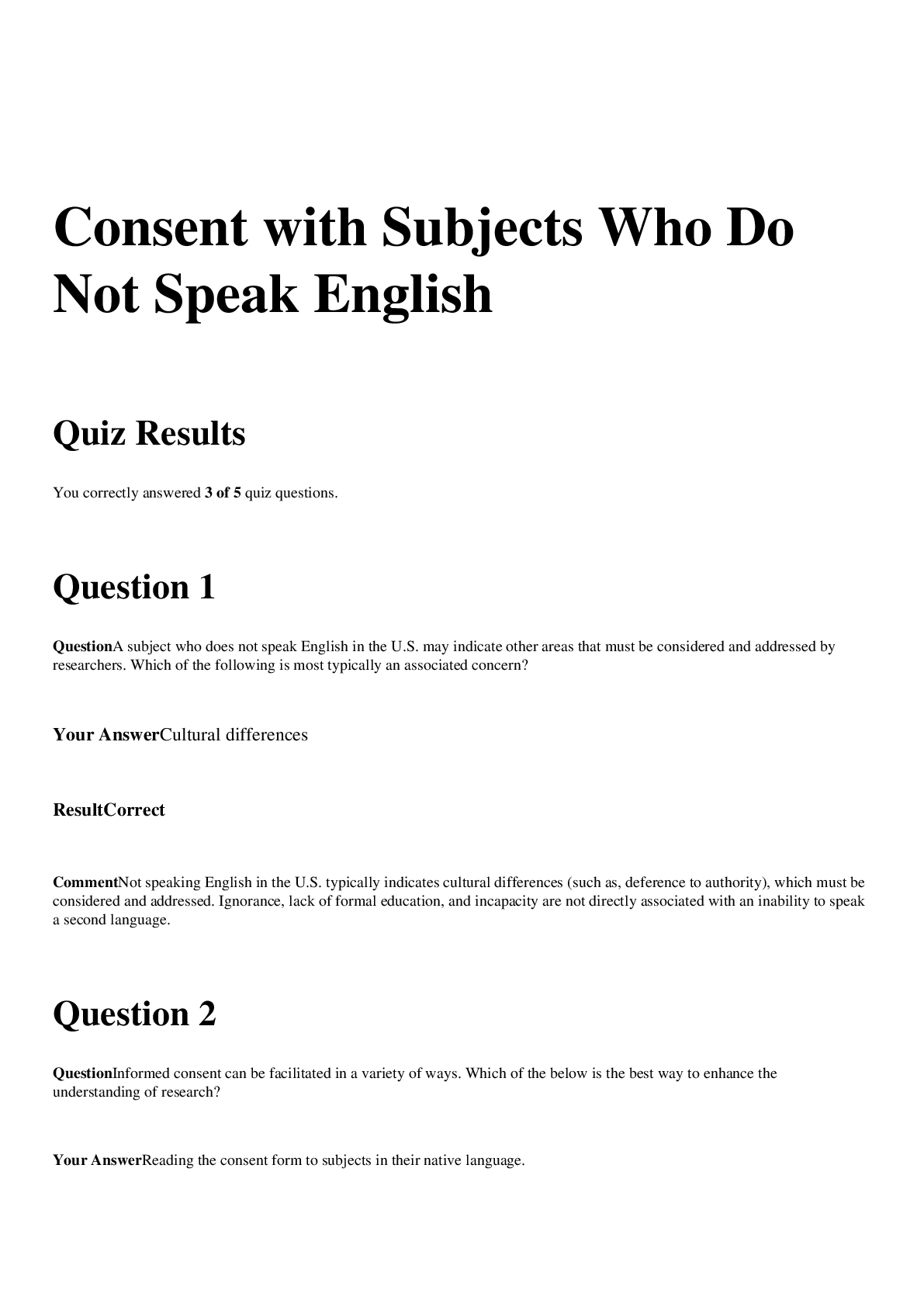
Instant download
Reviews( 0 )
Document information
Connected school, study & course
About the document
Uploaded On
Dec 27, 2022
Number of pages
36
Written in
Additional information
This document has been written for:
Uploaded
Dec 27, 2022
Downloads
0
Views
54

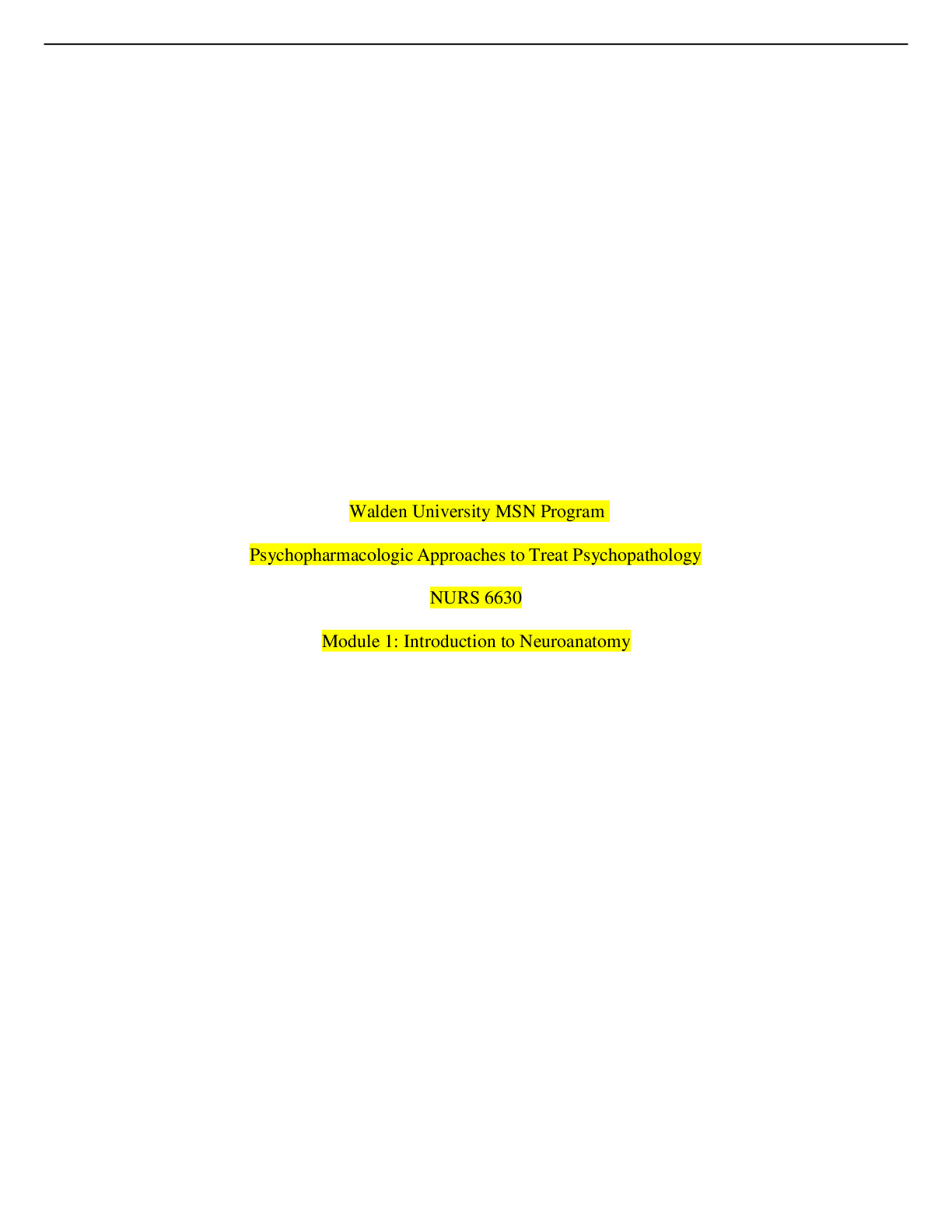





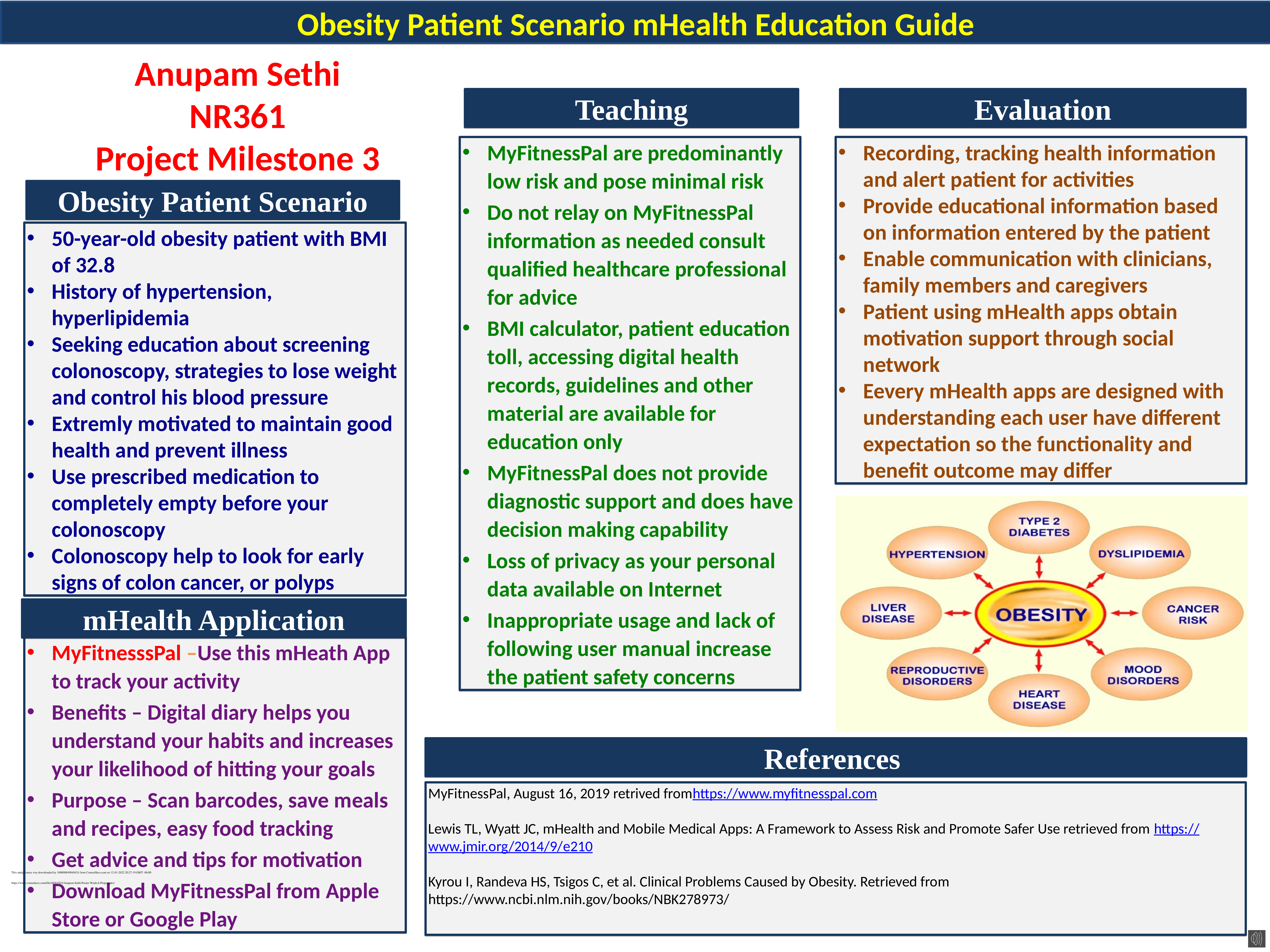



.png)
